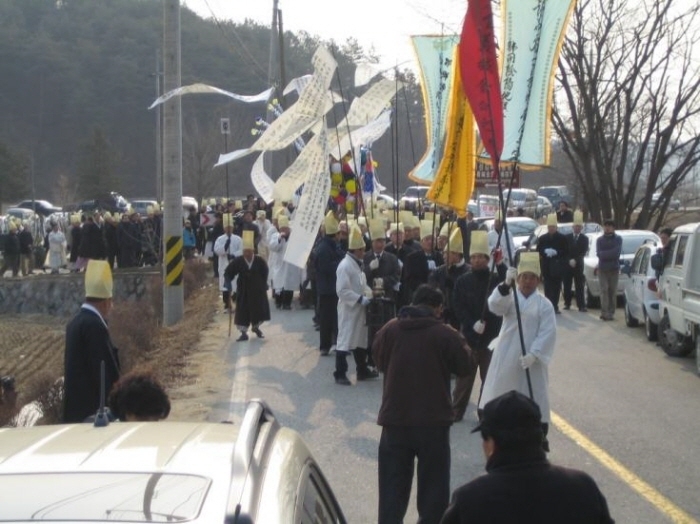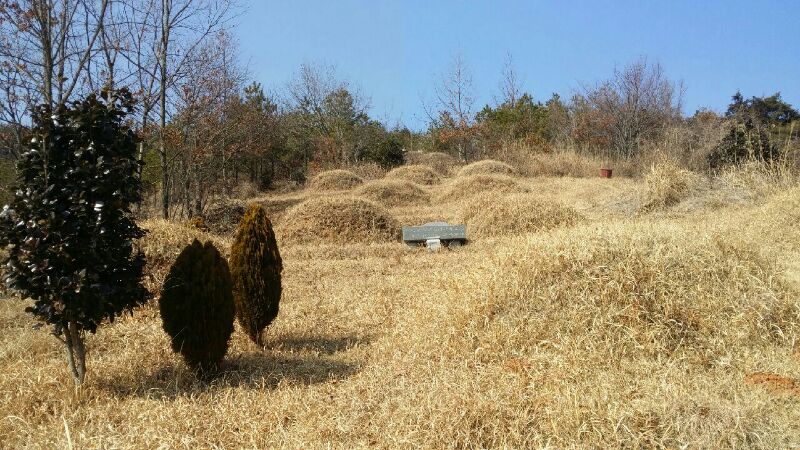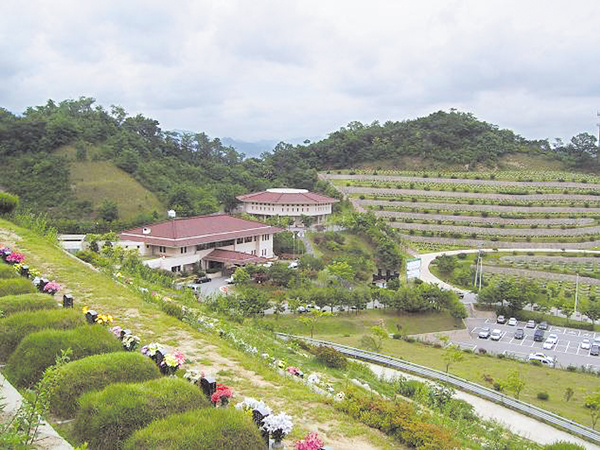Burying the Dead in Korea
Compiled and supplemented by David Shaffer.
Traveling along the expressway or the railway to Seoul, or anywhere in Korea, one is sure to see the hillsides dotted with pockets of grassy mounds – traditional burial sites. In his “The Korean Way” column in the Gwangju News, Prof. Shin Sang-soon (1922–2011) several times dealt with the subject of burying the dead in Korea. Here we compile three of Prof. Shin’s articles for a composite picture of the topic: “The Way of Burying the Dead” (February 2003), “Why Graves Are Moved from One Place to Another” (November 2004), and “Change of Mode of Burial” (September 2010). We would also like to note that his September 2010 article was Prof. Shin’s final contribution to his “The Korean Way” column before his passing months later. — Ed.
THE KOREAN FUNERAL
In a traditional Korean funeral ceremony, the body of the deceased will usually rest at home for at least three days after death, before being carried to the final resting place. Interment usually takes place on the 3rd, 5th, or 7th day after death depending on the situation. If any members of the bereaved family are far away from home and their presence at the funeral is considered necessary, the funeral rites are delayed, but customarily it is a three-day affair.
When a death occurs in a family, of either a parent or a grandparent, the news is immediately dispatched to all family and relatives, who then come to the house to prepare a shroud for the deceased and funeral clothes for close relatives. If the house is an independent and separate building with a fairly large courtyard, a large tent may be set up to receive guests. Room space is not readily available for visitors because it is occupied by those preparing the funeral clothes and the food for the funeral, and by relatives from far and near.

A funeral manager, called hosang chaji (호상차지), is invited to take charge of the entire funeral ceremony. He is usually a friend of the deceased, who is supposed to be very familiar with the funeral process. A flower-decked altar is prepared in the house, and a picture of the deceased draped in a black ribbon is placed in the center. To one side in front of the altar, the children of the deceased, now called sangje (상제, mourners), stand in the order of age, with the eldest being the closest to the
altar to receive condolence callers.
The shrouding usually takes place on the second day, the ritual in which a hemp or silk shroud is placed around the body of the deceased from head to foot. Afterwards, the shroud is secured around the corpse in seven places with hemp rope and placed in the coffin. Direct and distant kin wear hemp funeral clothes.
The funeral procession to the gravesite starts with the removal of the coffin to the funeral bier, called sang-yeo (상여). It starts on the third day after death if it is a three-day funeral. The bier is carried by 8, 12, or 16 male pallbearers, normally villagers or friends. Usually the male family mourners follow the bier to the burial site. If the deceased was a man of renown and virtue, dozens of funeral banners with laudatory phrases written on them follow the bier, donated by those attending the funeral.The gravesite is selected by a jigwan (지관, geomancer, or literally “earth diviner”) as a blessed site after studying the lay of the land and the surrounding area. At the burial site, an interment ritual is held before the coffin is lowered into the ground.
RELOCATING GRAVES
Koreans show particular concern about the location of gravesites of their ancestors. The relocation of the graves of noted celebrities’ ancestors is always newsworthy and never fails to attract public interest. Several decades ago, former president Kim Dae-jung relocated his father’s grave to a new site in Yongin, south of Seoul, when he was the presidential candidate. It was thought that the new site might be a better “blessed site” and more auspicious for the deceased’s offspring. Sure enough, Kim Dae-jung was elected president!
Another political personage, Kim Jong-pil, also relocated his father’s grave to a blessed site, which created the rumor that he was also expecting to run for the highest seat in the country. Then in 2004, the presidential candidate of the Grand National Party, Lee Hoi-chang, relocated his father’s grave, which was also widely reported by the media.
Why is ancestral grave relocation so newsworthy in Korea? To understand this peculiar social phenomenon, one must understand Koreans’ views of life and death. According to their traditional outlook on life and death, when a person dies, not everything related to the person disappears. For them, death means the separation of the hon (혼, soul) and baek (백, spirit). Hon is regarded as the nature of yang, bestowed by heaven, and when one dies it returns to heaven. Baek is regarded as the nature of yin, bestowed by the earth, and when one dies it returns to the earth with one’s body. That is, the grave where one is buried is the place where one’s baek resides, called a “yin-house” (eum-gye, 음계).
The concept of “house” during the Joseon Dynasty included not only the “yang-house” (yang-gye, 양계), where the living reside, but also the yin-house, where the baek of the deceased reside.
From this, we can surmise that Koreans have regarded life and death as a relationship between yang and yin, that is, between heaven and earth. Yang represents the positive or assertive cosmic force. Yin represents the negative or passive force. These twin forces are the two fundamental, interactive forces of nature, exerting influence on each other and initiating movement.
They explain the perpetual change in all things. One cannot exist without the other. We cannot experience light without darkness, stillness without movement, happiness without sadness, and so on. To be in balance, one must be in harmony with these two forces.
To build the ancestral yin-house in a blessed site is an attempt to exert affirmative influence on the living offspring. Likewise, a yin-house in a non-blessed site exerts negative influence. At the core of the concept of reburial lies the bones of the deceased as the connecting link between the deceased and their offspring. Bones residing in a blessed site transmit good energy to their offspring, while those in a non-blessed site transmit bad energy.
CHANGING BURIAL PRACTICES
In recent times, the problem of burial space has become a national issue. According to statistics, the area occupied by the dead is greater than that occupied by the living. Over a decade ago, Seoul municipal authorities attempted to set aside a portion of its administrative area to provide a large cemetery for Seoul residents. The plan, however, met with vehement opposition from the residents of the nearby area because of the feeling of repugnance that a cemetery at their doorstep would give. Seoul tried to persuade the citizens that the city was in dire need of such a public facility for convenient burials, but to no avail.
The Korean burial method has traditionally been subterranean interment; that is, burying the coffin in the earth on a hillside with an earthen mound on top. This practice includes pungsu-jiri (풍수지리, geomancy), the selection of a “blessed site” as the location for the grave. According to geomancy, a “blessed site” is required to guarantee good fortune and happiness for the offspring of the deceased. This is why so many people have roamed the mountainsides in search of an auspicious burial site. If a site has a mountain to its back with a flowing stream in front (背山臨水, 배산임수), a fine view, terrain on the left resembling a blue dragon (左靑龍, 좌청룡) and terrain on the right resembling a white tiger (右白虎, 우백호), then the location is supposed to be a blessed site. But such sites have now been exhausted. It is presently even difficult to find an ordinary spot for a gravesite.
This shortage of burial grounds has forced the government and social organizations to look toward another mode of burial: cremation. Statistics show that the cremation ratio is increasing annually. It was 13.7% in 1980, 17.8% in 1991, 33.7% in 2000, 52.6% in 2005, 61.9% in 2008, [and 82.7% in 2016]. We can see that five sixths of Korean funerals now involve cremation. Cremated remains are generally treated in one of three ways: stored in a columbarium, interred in a tree burial, and buried in a natural burial.
A columbarium (納骨堂, 납골당, napgol-dang) is a repository where cremated remains are stored. The remains are placed in a small ceramic or wooden pot that is stored in a niche within a structure of multi-tiered compartments, so that one building may contain thousands of pots, thus making huge burial grounds unnecessary.
In the case of a tree burial, the bereaved family will choose either an evergreen or deciduous tree (not too young) for the tree burial. They place the cremated ashes in an unbaked clay pot and bury it under the tree, or scatter the ashes around the base of the tree, and hang on the tree a plastic tag or plaque with the deceased’s name and dates of birth and death inscribed on it. In time, the tree will grow larger and form a fine specimen. Some time ago, one of the prominent clans of Korea declared that it would conduct its clan funerals by tree burial. Many others are sure to follow suit.

A natural burial is like a tree burial, but instead of using a single tree, a natural burial selects a garden of flowering shrubbery as a suitable burial ground. A small hole, large enough to hold the clay urn, is dug amongst the shrubbery and the ground is leveled after the urn is placed underground. A memorial slab is placed over it with the deceased’s name and dates of birth and death on it. There is not much disturbance to the surroundings. In time, the unbaked clay pot will disintegrate into the soil with its ashes to nourish the plants. No damage is done to the area. The burial site looks the same as before – as natural as before. That is why it is called a natural burial.
Now a growing number of people use cremation as their preferred mode of burial, and various organizations – municipal, religious, and commercial – have built columbaria for social services. Bereaved families can use these facilities at a reasonable price. This has alleviated many municipalities’ difficulties in providing sufficient burial facilities for their residents.
The largest memorial park in the Gwangju area is Youngrak Park, located in a wooded area of Buk-gu in the direction of Damyang. It contains cemeteries, a crematorium, and several columbaria within the park area.

THE EDITOR
David Shaffer is a long-time resident of Gwangju. In 2020, he is spending his fifth Year of the Rat here. He has written about the lunar calendar and Lunar New Year customs in Seasonal Customs of Korea (Hollym). Dr. Shaffer is the chairman of the board at the Gwangju International Center and the editor-in-chief at the Gwangju News.








One thought on “Burying the Dead in Korea”